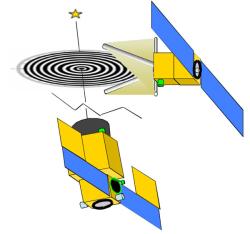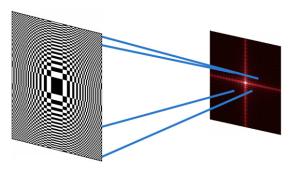 A proposed space telescope would focus light primarily with a patterned sheet of metal rather than a large mirror or lens. The telescope would have amazingly sharp vision and could spot Earth-size planets around other stars, its backers say.
A proposed space telescope would focus light primarily with a patterned sheet of metal rather than a large mirror or lens. The telescope would have amazingly sharp vision and could spot Earth-size planets around other stars, its backers say.
Telescopes used for astronomy normally focus light using a curved mirror. But there are limits to how large a mirror can be sent into space. That' + char(39)+ N' + char(39)+ N' + char(39)+ N's because of the tremendous cost of lofting heavy objects into orbit, as well as the limited cargo capacity of launch rockets.
But a team of scientists is experimenting with a completely different approach for focusing light. It does not require a large primary mirror or lens, though it does use a smaller secondary mirror and lens.
 The technique takes advantage of the wave nature of light, which causes light to bend around an object' + char(39)+ N' + char(39)+ N' + char(39)+ N's edge. The same phenomenon, called diffraction, is the reason you can hear sounds coming from around the corner of a building.
The technique takes advantage of the wave nature of light, which causes light to bend around an object' + char(39)+ N' + char(39)+ N' + char(39)+ N's edge. The same phenomenon, called diffraction, is the reason you can hear sounds coming from around the corner of a building.
This means that light can be focused into an image simply by passing it through a certain pattern of holes carved in an opaque sheet. Such patterned sheets have long been used for focusing laser beams, but have so far not been used for astronomy. They are called Fresnel zone plates, after the French physicist Augustin-Jean Fresnel, who studied diffraction in the 1800s.
But a team led by Laurent Koechlin of the Observatoire Midi Pyrénées in Toulouse, France, says a powerful "Fresnel imager" could be made by launching a piece of metal foil, cut with the Fresnel pattern and attached to a solid frame, into space. A spacecraft equipped with a camera and other scientific instruments would sit at the focal point some distance away and record the observations.
Sharp vision
Because it relies on a foil sheet rather than a massive mirror, it could be much more lightweight, and therefore less expensive to launch, than a traditional telescope.
A Fresnel imager with a sheet of a given size has vision just as sharp as a traditional telescope with a mirror of the same size, though it collects just 10% or so of the light. It can also observe in the ultraviolet and infrared, in addition to visible light.
The imager can take very detailed images with high contrast, which is great for "being able to see a very faint object in the close vicinity of a bright one," Koechlin told New Scientist. "We could obtain images of an exoplanet system," he says. Such images have so far been very difficult to make because planets are so faint they get lost in their host stars' + char(39)+ N' + char(39)+ N' + char(39)+ N' glare.
Signs of life
A 30-metre Fresnel imager would be powerful enough to see Earth-sized planets within 30 light years of Earth, and measure the planets' + char(39)+ N' + char(39)+ N' + char(39)+ N' light spectrum to look for signs of life, such as atmospheric oxygen. The Fresnel imager could also measure the properties of very young galaxies in the distant universe and take detailed images of objects in our own solar system.
Although it would be lighter than an ordinary telescope, a 30-metre Fresnel imager would still be daunting to launch and deploy. Such a large piece of foil would have to be folded up for launch and then unfurled in space – a potentially tricky manoeuvre.
Koechlin' + char(39)+ N' + char(39)+ N' + char(39)+ N's team proposed a smaller mission to the European Space Agency, which would have used a 3.6-metre piece of foil. Their proposal was in competition with dozens of other proposed space missions seeking funding as part of ESA' + char(39)+ N' + char(39)+ N' + char(39)+ N's Cosmic Vision 2015-2025 programme, and was not selected as one of the 10 finalists.
Despite its strengths, there are some serious challenges involved in mounting even a smaller Fresnel imager mission.
Precise alignment
For one thing, the light comes to a focus far away from the foil sheet – with distances measured in kilometres, which means the camera and other instruments have to be mounted on a separate spacecraft. The instrument spacecraft would have to stay precisely aligned with the foil sheet, to within a millimetre or so.
That could be especially tricky considering how much the two spacecraft would have to move around. With every new target, the Fresnel plate would have to swivel around, and the instrument spacecraft would have to move to the new focal point, which could end up using a lot of fuel.
Another problem is that the Fresnel zone plate focuses light differently depending on its wavelength, which if uncorrected would lead to distorted images. But Koechlin says a specially shaped lens – called a Fresnel lens – placed on the second spacecraft could intercept the light just before it reaches the instruments to correct for this.
Koechlin' + char(39)+ N' + char(39)+ N' + char(39)+ N's team envisions putting the two spacecraft at one of the Earth-Sun Lagrange points, where the gravity from both bodies balances out. There, it is relatively easy to keep the spacecraft precisely aligned with one another, but the formation flying would still be a major challenge.
Star shade
Marc Kuchner of NASA' + char(39)+ N' + char(39)+ N' + char(39)+ N's Goddard Space Flight Center in Greenbelt, Maryland, US, is studying another approach for detecting Earth-sized planets, which involves a more traditional space-based telescope flying in formation with a star shade that would cut the glare from the parent star to make planets easier to see.
He says the Fresnel imager has an advantage in that the foil sheet can be made very large, giving it very sharp vision. But when practical considerations are factored in, he says it is not clear how it stacks up against other ideas. "We need to study the practicalities of deploying and flying these large optics," he told New Scientist.
One potential difficulty for the Fresnel imager is that even small amounts of sunlight could bounce off the foil sheet and into the camera or other instruments and interfere with observations, he says. Koechlin' + char(39)+ N' + char(39)+ N' + char(39)+ N's team agrees that this is a potential problem and says shades would be needed to block light from reflecting off the foil sheet this way.
Proof of concept
Ben Oppenheimer, a planet hunter at the American Museum of Natural History in New York, US, thinks more research needs to be done before seriously considering using the device in space. "[It' + char(39)+ N' + char(39)+ N' + char(39)+ N's] certainly an interesting thing to pursue, but by no means is this near the level of maturity needed to propose major space missions based on it," he told New Scientist.
Koechlin is leading a series of experiments designed to prove the feasibility of a Fresnel imager. His team has taken images of objects around the laboratory using a credit-card sized sheet of stainless steel carved with the Fresnel pattern.
Next, the team plans to construct a small ground-based Fresnel imager telescope by attaching a 20-centimetre patterned sheet to a telescope mount. When it is ready about a year from now, they plan to take images of astronomical objects as a proof of concept.
The research was presented this week at a conference on formation flying in Noordwijk, The Netherlands.

 Previous page
Previous page Back to top
Back to top







